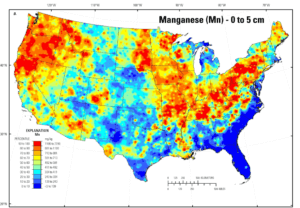Contaminants in Drinking Water Supplies
Like calcium, manganese is a naturally occurring element commonly found in minerals, often in combination with iron. It can be found in soil, water, air, and many foods, like seeds and nuts. In the U.S., manganese levels in the soil can vary significantly by location (see map). Depending on where your drinking water comes from, there’s a good chance it contains trace quantities of manganese. Consumed in small amounts, manganese is an essential nutrient for maintaining a healthy body, just like calcium and iron.

The manganese content in U.S. soil (red = high manganese areas). Map courtesy of the U.S. Department of the Interior, U.S. Geological Survey, Mineral Resources Program
The U.S. Environmental Protection Agency (EPA) has guided acceptable levels of manganese in drinking water, measured in milligrams per liter (mg/L). No regulatory limit has ever been set; therefore, many communities (mainly in rural areas) don’t test their drinking water’s manganese level. This is primarily because manganese was viewed for decades as more of a nuisance issue, often turning water brown and staining sinks and fixtures with black deposits, but any health impacts were largely unknown.
High Levels of Manganese in Drinking Water Can Cause Long-Term Health Issues
However, ongoing research studies over the last two decades have shown that elevated levels of manganese in drinking water can lead to adverse neurological effects. These effects are most likely to occur in older adults after a lifetime of exposure to high element levels. However, some studies have also shown that too much manganese during infancy and childhood may impact learning and behavior in children.
These findings led the EPA to update its water quality regulations by establishing a health advisory level (HAL) for manganese in drinking water supplies. The HAL allows states to issue a Public Notice to communities with manganese levels in the water supply that exceed the HAL specifications. When a Public Notice is issued, consumers must use bottled water for drinking, mix formula for infants, and prepare food until the drinking water supply is properly treated. Unfortunately, boiling water with high concentrations of manganese can increase the levels and is not recommended.
Drinking Water System Testing & Analysis
While treating the water supply for manganese and other contaminants is common practice in most communities, many small communities don’t have the resources or equipment necessary. Snyder & Associates has years of experience helping communities of all sizes address their water treatment options. Whether you need to improve an existing water treatment facility or build a new water treatment plant, cost-effective and intelligent solutions begin with a complete water system analysis.
The proper treatment method depends on several factors, including manganese levels, other contaminants, and existing treatment methods. Testing will also determine other water parameters such as pH, hardness, iron, sulfur, and oxygen content. All of this information is useful to help select the proper treatment option or equipment needed for your particular application.
Common Treatment Options for Manganese
Conventional treatments for managing manganese in drinking water supplies range from phosphate treatment to oxidation and filtration methods. For low concentrations of manganese, a sequestering process that uses phosphate compounds is a simple and inexpensive solution.
When concentration levels are too high to use phosphate for sequestering, oxidation, and filtration are perhaps the best, most common form of manganese treatment. During this process, an oxidizing chemical is pumped into the water supply. This converts soluble manganese into a filterable form. The resulting solid particles can then be filtered out of the water. The type of equipment necessary for this process is widely used at water treatment facilities across the country.
Other technologies that can remove manganese include ion exchange, lime softening, and reverse osmosis. Reverse osmosis involves using hydraulic pressure to force water from a concentrated solution to a diluted solution, trapping any contaminants in the concentrate.
These methods have particular benefits depending on a community’s needs and resources. Through our water quality data analysis, we’ll recommend the treatment process design that provides the right balance for your community.
Water Infrastructure Funding & Permitting Assistance
Snyder & Associates recognizes the impacts an upgrade and improvement can have on communities, both large and small. With years of knowledge and experience with outside funding sources, we can guide you through the necessary steps to acquire water infrastructure project funding. Numerous state and federal funding assistance programs are available to help communities with water quality improvement projects. No matter where your community is located, we’ll assist you in navigating all program requirements and completing and submitting funding applications.
Likewise, our team can coordinate the extensive permitting process for water quality improvement projects. Our experience and relationships with regulatory agencies help to keep projects on schedule and within budget.
Addressing Manganese in Your Community’s Water Supply
There are many different methods available for properly treating manganese in drinking water, but the proper first step is testing. If you have concerns that your community may have elevated manganese levels or any other contaminant in your drinking water supply, the Snyder & Associates team is available to put together a plan to meet the needs of your community’s needs and address current and future water quality regulations.
